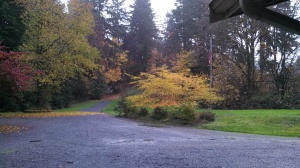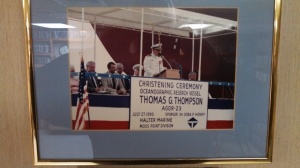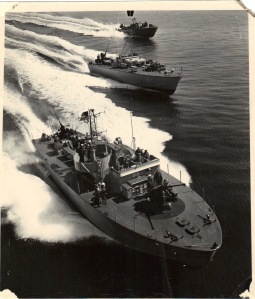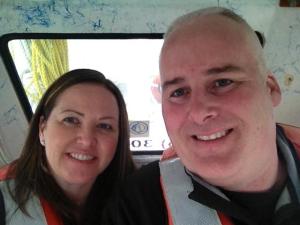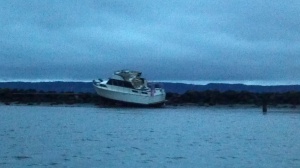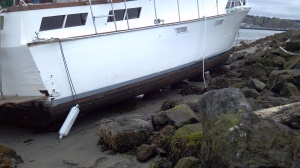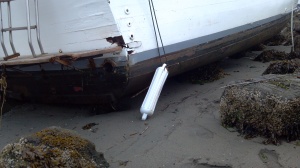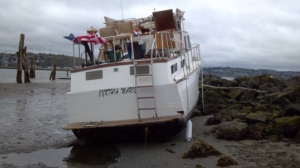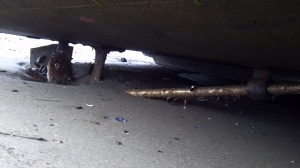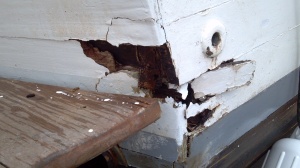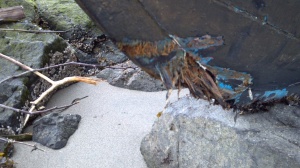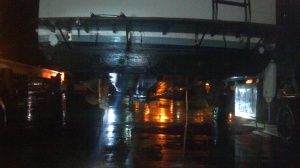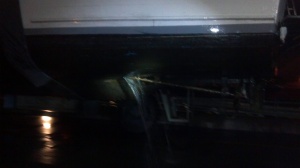We offloaded last week in Esquimalt, British Columbia just West of Victoria on Vancouver Island. Esquimalt is home to the Canadian Navy (West Coast) and has a really nice shipyard where we offloaded and had one of our deck cranes repaired. Here are some photos:
Category Archives: Navy
Gulf of Alaska, Ocean Station Papa
We steamed out of Seattle straight into a gale headed for Ocean Station Papa. Station P. lays approx. half way between the W. Entrance to the Straights of Juan De Fuca and Dutch Harbor Alaska.
The next seventeen days were mostly
misery. Well not quite that bad as the low pressure systems move through pretty quick and it take a couple days for the next one to arrive. Our worst was gusts to 55 knots with seas around 25 feet. The worst part was at the start of my watch the wind would be from 270 and by the end was at 360. There was no good heading to be on, they were all fucked. We were hove to babysitting some drifting instruments and the ships dynamic positioning systems was totally overwhelmed do the mate and I took 15-20 minute turns hand steering as best we could. Couldn’t get any pictures.
This trip was pretty boring other than deploying two weather buoys in 4200 meter deep water and recovering one. The rest of the time we spent deploying drifters in the morning, buoysitting all day then picking them up in the late afternoon. Then we would hove to overnight and repeat. I swear to god it felt lkke ground hog day each day. It got daylight at 0900 and dark by 1600.
The drifters or swifts: (we called them lawn darts)
The noaa waverider buoy we deployed:
Probably the best fun was when the chief scientist sent some students out to spool some line on the deck winch. The line is coated in vectran to reduce drag through the water. They spooled most of line (loosly) to one side of the drum. The ship took a heavy roll and the line totally fur balled on the drum. it took them nearly 12 hours to pull it off by hand and respool correctly.
Hard lesson learned by the youngins.
Toward the very end of the trip the weather looked like it might turn out pretty nice, which was great for the crew but not great for the science party. Thier research focuses on the mixing and turbulence caused by breaking waves. No waves – no data for them. Since we were something like an 85 hour steam back to the coast, they decided to steam in and hold off about 200 nm off the coast and hope for another system. Our first day closer to the coast was really nice with the air temp at 57 find no wind….
It did slowly build to about 25 knots overnight and the science group was estatic. At that point, time was up and we slow steamed back to Seattle.
We have another three week break in our schedule before our next trip so I hopped on the baby brother to the TGT, the Clifford A. Barnes for a five day trip. We are currently sampling mud in Hood Canal. More details later.
TT
Respect
The photo above is the best shot I could get of Guadalcanal, Solomon Islands as we passed by yesterday morning. We were several miles offshore and even from that distance, the terrain looks nearly impassable let alone to try and make an amphibious beach assault, advance against a determined and fortified enemy, and even be able to move equipment and supplies forward. Yet that is exactly what the U.S. Servicemen did here during WWII. Their accomplishments are even more amazing after seeing this place in person even from this far away. I give the fullest respect and honor to those who were here and fought.
In other news: I received the dreaded phone call from home yesterday and will be cutting the trip short at the next port in a couple days. My mom is a fighter and I’m going to go be with her and whip her into shape and get her back to her fighting weight very soon.
You all be good while I’m away!
Todd
Summer wind down, student cruises and transit to Ecuador
Welcome back Blue Ocean Mariner readers! It has been so long ago that I made a real post, that I had to go back and read where I left off. I had tried several times onboard the ship to update, but the internet was so slow that I ultimately abandoned the effort several times. I’ve debated entering several smaller posts over the next week, but decided to just make one big entry and dump it all out at once so I don’t forget anything.
Jason ROV – Axial Seamount:
Just after offloading the ROPOS ROV in Victoria (see earlier post) and returning to Seattle, we had a 10 day stretch at the dock where we caught up on maintenance, organized the deck for the next oncoming science party and began to receive their equipment onboard. The next trip was with the Woods Hole Jason ROV. The loading all starts with a 175 Ton shore side crane coming in and loading all of the heavy lifts. They start on the bow and load containers of spare rov parts, then move to the aft deck and load the rov control vans and the rov and rov launch crane. Then the shore side crane leaves and everything is wired, lashed, bolted down, organized, etc.
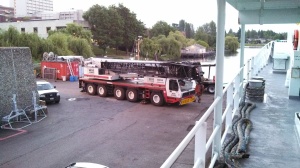
We headed back out to the Axial Seamount, 300NM off of Central Oregon. This is the same project we were on the last leg with the ROPOS ROV. The ROPOS leg was installation of the cabled observatory with lots of instruments, cables, junction boxes and related hardware being deployed. This leg with Jason studied the hydrothermal vents, microbiology, oceanography, energy and other things I don’t fully understand. For example, one of the projects included putting a cap on a hydrothermal vent and creating an electrical energy source. The experiment was a success and they were able to generate a pretty good amount, although I can’t remember what that was.
We also spent considerable time deploying benchmarks that were set in several locations on top of the seamount. Then a super accurate pressure sensor was placed on top of each benchmark and recording were taken. At future visits to the seamount, more readings can be taken and note the changes in elevation of the seamount. The seamount has risen 11′ since 2011 and may be getting ready to erupt again soon.
Unlike the ROPOS ROV which uses the lemon floats to carry the weight of the cable, the Jason ROV uses a unit named Medea that bears the load of the cable and then tethers the Jason ROV so that the ROV can roam freely without being shock loaded be the cable as the ship surges in the sea. The other notable feature of the Jason system is that the Jason crew takes control of the ship while they are diving on station. They can slowly maneuver the ship from their control van and have it follow the rov where they need it to go. The control of the ship can be immediately returned to the bridge if the need were to arise.
That’s all fine and dandy until the bow thruster takes a dump. The thruster itself did not die, but rather the motor that controls the direction of thrust. There was no way possible for the ROV control van to control the ship without a functional bow thruster while sitting on DP. Control was resumed on the bridge and every time the ROV needed to move a phone call was made to bridge to explain where they wanted to go and at the same time a electronic chart on the bridge was updated by the ROV control showing the heading and distance to their next location. Along the same time we had some incredibly calm conditions that actually made keeping the ship on course harder. It was easier with about 15 knots of wind and gave some force to lean into. Without the wind, controlling the bow was a challenge. Near the end of the trip, the work around consisted of calling the engineers and having them move the thruster to either 90 or 270 and then the bridge could apply thrust in the direction they wanted to go. It helped tremendously to maintain the ship on station and the ROV was able to complete their job.
We did manage to sneak in a few barbeques on the bow for over the trip due to the great weather:
At the end of the trip, we again went to Victoria, Canada to offload a bunch of our science party. They were boarding the R/V Falkor. The Falkor is owned by Schmidt Ocean Research Institute and was started by Eric Schmidt of Google fame. We tied up directly behind the Falkor and in the photo you will see the ROV ROPOS onboard while the ROV Jason is onboard our ship, the Thomas G. Thompson. If you look closely at the photo of the Falkor, you can see that they have two satellite domes. I seriously doubt they have any issue connecting to the internet, especially when your boss is the CEO of Google.
We were only in Victoria about four or five hours and then departed again for Seattle. With no functional bow thruster, we had to be taken under tow by a Western Towboat tug to pass through the locks. As the lock gates opened and the towboat leaned on the throttles, there was a huge explosion of salmon off the boat of the tug. The engine noise must have scared them. It was right during the peak of the salmon run. Unfortunately I was unable to take a picture.
Western Towboat towing the Thompson:
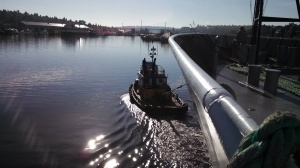
Student Cruises:
Part of the University of Washington charter agreement with the Navy is to provide so many days of student learning / cruises. Many of the crew do their very best to schedule their time off during these evolutions. You can see from the schedule below were in and out of port numerous times sometimes a few times per day. The weather during the student cruises was FUBAR as well, making things more difficult. We had gusts to 40 knots in Puget Sound and solid rain for the week. I enjoyed the student cruises for the most part. We earned lots of overtime and I really got a chance to work the mooring lines multiple times (which is a great workout).

The student trips were run mostly from pier 91 in Seattle, which allowed much easier tie ups than going all the way into the locks to the University Pier. Pier 91 is where most of the large trawler fleet is based. These trawlers fish the Bearing Sea and the coasts of Oregon and Washington for hake, sole, cod, etc.
During one of the cruises, we stayed tied to the pier. Overnight a huge cruise ship docked just off our bow. In the morning, we had to thread between a couple of factory trawlers on the left and the cruise ship on the right. The wind we blowing off our Stbd. Bow as we left the dock. As we passed the cruise ship, it blocked all the wind, then as we came out from behind the ship the wind blasted us again. The crew did a great job keeping us off the line of factory trawlers.
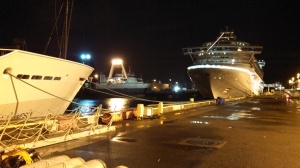
The hole from a different view. We came out just to the right of the cruise ship on the right:
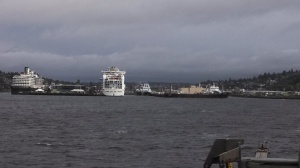
Pier 91, where the student cruises launched from, has great views of the downtown Seattle skyline:
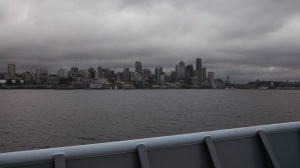
A couple of the student cruises were all the way out to the coast off of La Push, WA. The first time (early in the week) was to restive a scientific mooring / buoy and bring it to port so it could be maintained. Along the way we did a number of CTD stations. I forgot to take a photo of the CTD unit itself, but it basically takes water samples at various depths dictated by the science party. The CTD is deployed on out Hydro Boom that stick out of the Stbd. side of the ship and is deployed / retrieve with our winches.
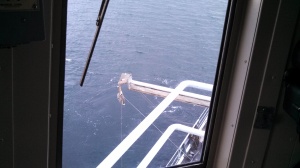
Winch control station and view from the winch control:
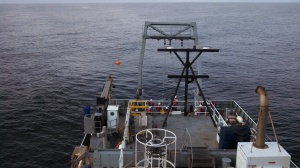
At the end of the week we took on fuel, getting ready to depart for South America. The fuel dock has a nice view as well:
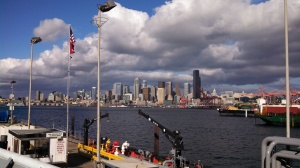
The fuel pier we use, is right next door to Northland Services. Here is one unique barge that loads containers on the top and then loaded rail cars are loaded on the bottom. When they arrive at their destination, they wheel the rail cars off. Pretty cool idea!
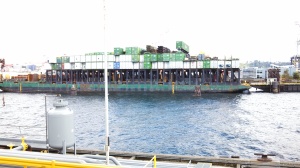
A couple of Western Towboat tugs arrived to make up to the Northland Barge.

On the other side of the fuel pier is the Vigor Shipyard (formerly Todd Shipyard). They are overhauling the USCG Icebreaker Polar Star:
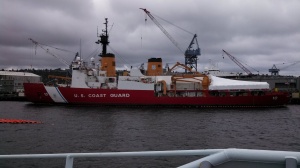
Somewhere during the student cruises, the Thomas G. Thompson celebrated her 300th voyage:

At the end of our student cruises, we had one last entry into the Ballard Locks and the ship canal. Inside the Ballard Locks:
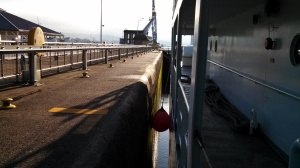
Some fishing vessels waiting for us to clear out so they can enter the locks and the Corbin Foss waiting to exit:
One last time to the U of W Dock. Same thing as before, a shore side crane came along side the next morning and loaded 7 containers beginning on the bow. Two of the containers on the bow are refrigerated that will be used to hold garbage while in the tropics on a long leg. There was a scurry of science people that arrived and seemed allot like anarchy as each group wanted priority over their equipment to be loaded, hooked up, lashed, etc. It’s surprising no one was injured.
One of the containers that was delivered to us on a long haul truck, also had a wrecked car as part of the load. The crane operator thought it would be funny to make it look like they smashed the car by accident with the container. The next morning, the University’s Port Captain and Marine Superintendent came onboard for breakfast and I showed the car we smashed the day before. They just sat looking at the photos in disbelief and wonder why the accident wasn’t reported until I spilled the beans that it was all a set up photo.
It looks pretty real, doesn’t it?

We pulled off the U of W Dock one last time. The Thompson won’t be back again until next summer.
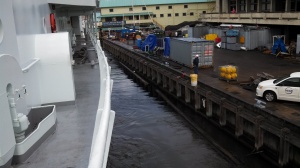
On the way out we passed Western Towboat and their nice shiny fleet. They keep their equipment in perfect condition:
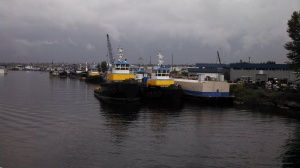
Also passed Kvichak, builders of some really badass aluminum boats:
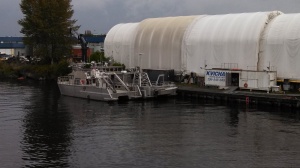
We made our way into the locks and everything was going fine. I was assigned to the bow, as normal with a couple of other ab’s. To exit the locks and head to sea, you would have to normally wait for a train bridge to be opened. Normally we would sit in the locks with gate open, waiting for the bridge. While we sit the water has a chance to mellow out and there is very little current when we do pull out. I’m pretty sure the bridge was telling us to come on through or something, because we didn’t wait like normal for the current to mellow out. As we started making way, we picked up some pretty good headway, maybe four knots. The lock attendants are always reminding us to mend our fenders as a vessel last year has failed to and their fender ripped some sections of fencing gate off the locks. With the headway we were making, I took one look at the fenders and mentioned to the other AB that if the ship were to come close to the wall, to get the fuck out of the way. There would be no way to manage the fenders when the weight of the vessel pushed them up to the wall and they came tight. I was more worried about the lines holding the fenders snapping and killing or injuring one of us. We were plenty far enough from the wall in our area (amidships), but just as I had said to run if the lines came tight, we noticed the stern coming close to the wall and the fender riding up and coming tight. Just then, our young Third Mate came out from behind the rear crane clutching her hand in agony. She had tried to mend the fender and got some fingers pinched when the line came tight. The vessel couldn’t do anything but proceed out of the locks and through the bridge. Once outside of the bridge and the entrance channel, we were able to heave to and launch the rescue boat and evacuate her to a waiting ambulance to get checked out. Turns out she broke three fingers and lost some skin. She was super lucky that it was just the very tips of her fingers and she should have a full recovery. (update: she missed to transit to Ecuador but rejoined as the ship arrived in Ecuador). Here a few photos I took of our third mate being whisked away in the rescue boat:

The water was flat calm when we evacuated the mate. After we retrieved the rescue boat and got underway for Ecuador, the winds picked up really quickly. We still had a bunch of stuff to lash and were working fast while we still had the protected waters of Puget Sound. Then as fast as the wind came up, it died and turned out to be a really nice evening as we approached the Olympic Mountains and the Straights of Juan De Fuca:
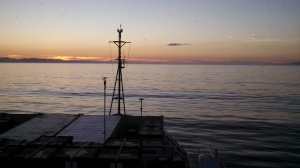
As we approached the West end of the straights we started to feel a pretty good ground swell. As we made the turn at Cape Flattery we got hit on the beam with 14′ swells that lasted for about 12 hours and made the ride pretty sloppy. Further down the coast we turned again and put the swell on our stern and made a nice ride all the way beyond San Diego. Our course lines were obviously drawn by a non fisherman. Everywhere there was good structure like a underwater canyon, ledge, seamount, etc., we were at least 80 miles from it. We passed some very famous fishing spots such as Guadalupe Island, Alijos Rocks, Hurricane Bank, Cocos Island to name a few. Fishing turned out to be a bust for the entire trip and making 12 – 14 knots didn’t help either.
As we made our way down Baja, we started to feel the effects of a tropical depression named Octave followed by a weak system named Priscilla. We ended up get hit with 40 knots of wind and about 15′ seas. The wind petered out very quickly and the swell didn’t last too long either. The next day, Priscilla had strengthened and moved West so we missed her, but she did give us a half of a day of swell on our beam.
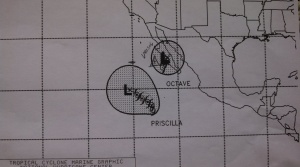
Finally we received some hot, flat and humid tropical heat for a few days.
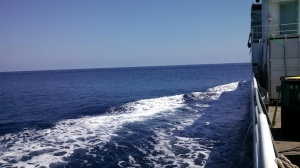
THIS IS NOT A DRILL! Saturday afternoon, after watch, I was in my rack enjoying some sweet dreams when the alarm rang and the announcement came over the speakers “this is not a drill, report to your muster station, fire onboard”. I slapped on some clothes and hit the muster station. There was a fire in the engine room. It turned out to be a water jacket heater on one of the Cat 3516 main engines. The thermostat shorted out and melted the wires which in turn burned some rubber and made allot of smoke, but no fire. It was put out by turning off the electrical to the unit. It was a good muster and the crew was suited up quickly and efficiently.
Pollywog to Shellback:
The evening before we arrived in Ecuador, we crossed the Equator. I was a pollywog but now am a Shellback. At the time we crossed, it was pretty tense on the bridge as there were numerous pangas fishing the area that did not show up on radar. They also don’t have lights, or I should say they don’t turn on their lights until you right on top of them! I tried to take a photo of 000 but missed it by a hair:
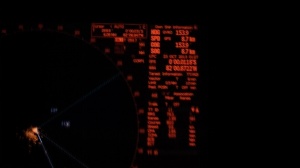
We arrived in Manta, Ecuador after 16 days at sea. We met the pilot boat and made our way to the pier. At the dock were numerous seiners unloading net loads of super small tunas. These are the super seiners that wrap entire schools in their 2 mile seine nets and have helicopters onboard to find the tuna. It was pretty bad in my opinion.

We tied up, put out the gangway, let the pilot off and greeted the customs and immigration officials. It took several hours to clear into the country. They allowed the oncoming crew and science party to board, but not for us to depart the ship. This gave us time to finish packing, clean our rooms for the next crew, have lunch and just hang out for a bit. It also marked the 80th day I had been aboard and I was ready to get off asap!
We were finally cleared by the Ecuadorian Customs and several of my crew mates and I went a few miles down the beach to a hotel, where one of them booked a room (their flight wasn’t until the next day). Myself and several others were flying out later that night so we stuffed our bags in the hotel room and made our way to the bar to have some beers and food. I was struck by how nice the roads were in town. I had imagines Ecuador being really bad and broke down, but the little bit of it I saw was pretty nice. The hotel was excellent as was the airport. We only got to see a few miles on either side of the port so we really didn’t get to see too much.
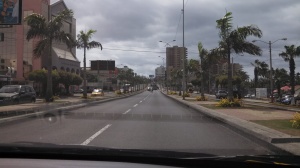
We made our way to the airport and flew to Quito, the capital of Ecuador. It was already dark when we flew in so we couldn’t see too much, but it looks like a real cool place. From Quito we flew to Atlanta, then on to Seattle.
I arrived home and was met by my wife and kids at the airport. On the drive home we stopped in Seattle at the Coast Guard Rec Center and turned in the discharge papers, course certificate and assessments for RFPNW. I’m very happy to finally have that checked off the list.
There is a huge difference in the weather between Ecuador and my home, just North of Seattle. Fall has arrived along with the fall colors!
Epic Fail: Reserch Vessel
The restoration of PT658. The last functional PT Boat of WWII.
A group of dedicated WWII Vets have and saved and completely restored PT658. She is the last functional PT in existance today. These vets spent countless hours restoring PT658 over a 15 year period. PT658 is berthed in the Columbia River, near Portland, OR. If you in the area, stop by and visit.
Watch the video of the restoration here:
http://videos2view.net/PT658.htm
Here is the offical website for PT658:
http://www.savetheptboatinc.com/
PT658 from Wikipedia:
http://en.wikipedia.org/wiki/Motor_Torpedo_Boat_PT-658
Well done to all the vets who saved this piece of history!
Twenty and a Tow
Yesterday marked my twentieth anniversary to my better half. How she ever put up me that long, I have no idea. I half jokingly told her “watch, the phone will ring while we are at dinner and I’ll have to go tow some disabled boater in”.
Just as we were a couple miles from home, heading to our dinner reservation, the phone rang and it was Vessel Assist Dispatch. They had a case of a broken down sailboat at the mouth of the Snohomish River near the Everett Naval Station.
The weather was overcast, but not windy, so my wife said she would go with me and then we would go to dinner. We were underway in 25 minutes and at the river mouth in 35. No sign of any boat other than Naval Security. I called the guy on the phone (no VHF) and he said he was half way to Hat (Gedney) Island. Well that is about 4 miles from where they said they were. Some peoples descriptions of where they are just don’t make sense.
I had one tow last summer in the middle of the night where the guy said he was in the middle of the ferry lane off of Mukilteo. I motored out there and couldn’t find him. I got him on the phone and he still insisted that he was in the Mukilteo Ferry lane. Of course he had no GPS position or VHF but he did have a smart phone. I told him to download a GPS program and call me back with the coordinates. A few minutes later he called back with his position……..he was 15 miles away just off of Edmonds Ferry. Please have a working radio and a gps at a minimum!
So we hooked up the tow, brought her into their slip (even had my wife manning the boat hook on the bow) and headed to a lovely dinner overlooking Puget Sound at Ivar’s Seafood House in Mukilteo.
Edison Chouest’s AIVIQ visits Everett

Edison Chouest’s 360′ Icebreaking Anchor Handling Tug Supply Vessel (AHTS) AIVIQ has arrived in Everett (as noted in my previous post).
A few quick notes about her:
She’s 360′ Length x 80′ Wide x 34′ Draft
Bollard Pull of 200 Metric Tons
Carries 528,155 gals. of fuel
Heliport suitable for a Sikorsky S92 helicopter on the bow
Main Propulsion is Four Caterpillar C280-12 diesel engines, producing 5,444 hp each
She can make 5 knots through one meter (3.28′) of ice
She’s manned by a crew of 24. Here is the list:
1 Master Unlimited
1 Chief Officer Unlimited
1 Second Mate Unlimited
2 Third Mates Unlimited
1 Chief Engineer Unlimited
1 Assistant Engineer Unlimited
1 Second Assistant Engineer Unlimited
2 Third Assistant Engineers Unlimited
4 ABs
4 QMEDs (qualified member, engineering department)
4 Oilers
4 Ordinary Seamen
2 Food Handlers
See the AIVIQ’s Specs from Workboat.com Here.
She is an impressive vessel to say the least! I took a little cruise around the harbor today to get some photos and see her up close. Luckily for me, the U.S.S. Stennis has left port, so the security inside the harbor was a bit more relaxed. As I was slowly motoring out of the Snohomish River, I passed the Navy security patrol vessel headed upstream. I waved them over and, figuring it was better to ask permission rather than forgiveness as I would normally do, I asked if they would mind if I entered the harbor to take photos of AIVIQ and they said no problem. So I stayed wide off the Navy pier and as far away from the docked Navy ships as possible so as not to bother anyone or raise any hackles at the base.
I was hoping to also see the Ocean Wave, Crowley’s powerhouse tug and the Sisuaq, Harvey Gulf’s Tiger Class Supply Vessel that was also in Everett, but just as I was leaving home to head to the marina, I received an email from Marine Traffic showing that both of these vessels had departed Everett.
I wanted to do this little cruise yesterday, but it was raining so bad I thought I’d wait a day for better photo weather. Today turned out to be rainy and windy also, but I figured I shouldn’t wait any longer or the AIVIQ may also depart. I grabbed my wife’s fancy Nikon (she’s not home) and snapped the photos. I need to take lessons on using a real camera and I’m not sure why the photos appear small on this blog. I’m still learning how to use this site and all of the features that is contains of which there are many. I hope to take good vessel photos like New England Waterman does someday.
AIVIQ with the Everett Alumadome. The alumadome holds wood chips for loading.

The Navy patrol vessel can be seen in this photo:

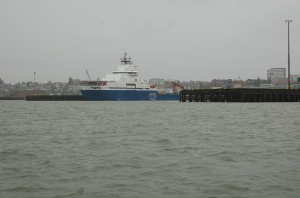
AIVIQ is an impressive sight up close!



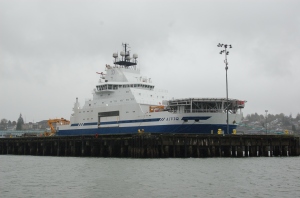
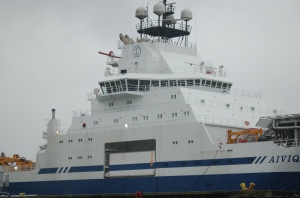
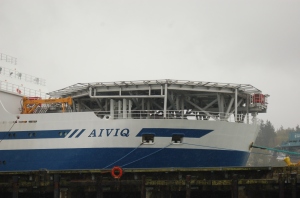
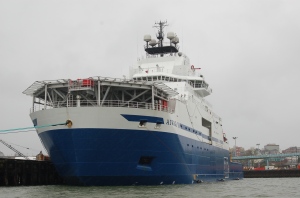
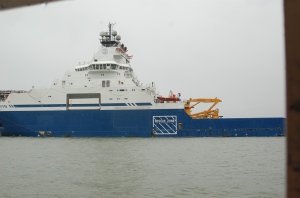
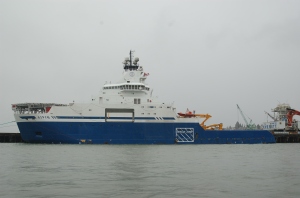
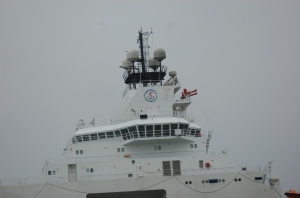

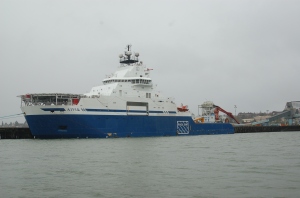
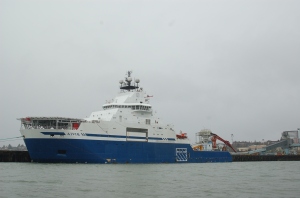
Just past where AIVIQ is tied up to the North, is where Dunlap Towing is located:

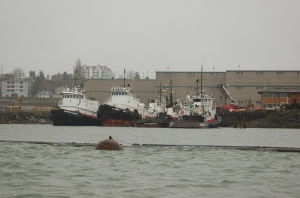
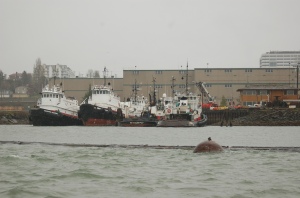
Just behind the AIVIQ is Brusco Tug & Barge:
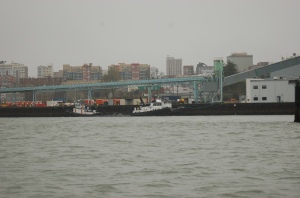


Some Harbor Cranes
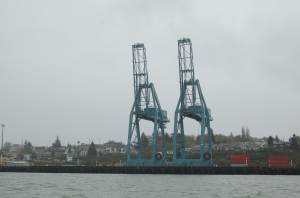
The Everett Alumadome again:

Three Hour Tour
0530 Yesterday morning the phone rings with the Vessel Assist Dispatch calling. They tell me the USCG is on scene of a boat hard aground on the rocks at Gedney Island with an uncooperative owner onboard (1 POB). The water is at the “cabinets” according to the dispatcher but the boat can’t sink any further than it already is and it is high tide (+11.2′). The coasties can’t get close enough in their 45′ due to the draft and have been standing by for a couple hours even though they came all the way from Seattle, approx 30 NM away. This run is about 25 minutes from our slip at the Everett Marina. I give them an ETA and get dressed and head towards the marina. On the way, the dispatcher calls back and says the Everett Police have removed the POB so I shouldn’t expect anyone onboard when I get there. They did confirm the boat was insured for liability only. I told them I hadn’t even seen the vessel yet, a 34′ Pacemaker with twin screws and a wood hull. Along the drive to the marina, the dispatcher calls back with updated coordinates passed along from the USCG which puts the boat inside the Everett Jetty and only about a quarter mile from my slip. It never did make sense that the Everett Police would be involved in any action on Gedney Island as it not their area of operations.
Arriving at the boat, I can see the flashing lights of the various agency boats (USCG, US Navy – they often help due to their 24 hour presence at the nearby Everett Naval Station, Everett Police) tied to the visitor dock on the far side of the Everett Marina. I get underway and motor over to see if they can give any information regarding the vessel and where / how the vessel was taking on water. The more information I can gather at this time, the easier time it will be when it comes to removing her from the jetty. If it has a gaping hole in the side would be a different response that a broken thru hull fitting. The coasties were most helpful even though they could not get any information from the owner. He refused to abandon ship and said he was a live aboard and all of his possessions were onboard. The USCG contacted the police and had him removed against his will in order to keep him from becoming a larger emergency. I asked if the vessel owner was available so maybe I could get any information but he had been released once arriving at the dock and he disappeared with a ride from someone but no one knew for sure.
I motored across the channel and snapped some pictures of the boat, even though I couldn’t get very close since the tide was ebbing and the boat was quickly becoming high and dry for the day. I stopped and talked to the US Navy boat and the USCG some more and let them know our tentative removal plans. I returned to my slip to send photos out to our other company boat and arrange an after hours, overtime haul out at the next high tide – 0300 this morning. While filing in some paperwork in the boat, the port security guard comes down the dock asking if I know where the “guy from the boat” went. I said no and that I had no phone for him and that I hadn’t even seen or been able to talk to him yet. The guard says the guy left his dog and computers with him and he couldn’t babysit the dog all day. This story just keeps getting better by the minute. A short while later the USCG Pollution Control guys from Sector Seattle Called and said there was a reported 50 gallons of gasoline onboard and asked if I could see a sheen on the water. I told them the boat was high and dry and no sheen would be possible to see until the tide comes in. I also assured them that it was very unlikely, with the position of the boat that the tanks had been breached in any way and I would keep a watch over it. They asked if they could drive to the scene (again no local knowledge). I said I would give them a ride in the boat to the Jetty Island Park and from there we could walk down the beach approx 3/4 mile to the wreck but going directly to the wreck by boat wasn’t possible due to the shallow water. They arrived about an hour later and we made the trek down to the boat and checked her out. Here are some pictures:
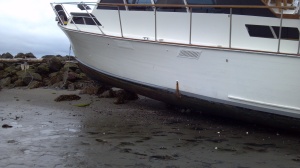
The saving grace for this old girl is the fact that she had a small solid wood keel running here full length. Had the keel not been there, I’m sure the rotten hull would have easily been penetrated by the rocks she laid on. I didn’t post any pictures of the interior of this vessel. Trust me when I tell you it was EFFEN NASTY inside. Anyone who even says they lived on her is disgusting. The coasties and I did our best to turn off the power, reset the anchor as best we could, plug up the fuel vents, etc. They were concerned that the next tide, she would float her enough to pound the rocks into the hull and lose the fuel. I assured them we would have it removed at the next tide cycle and not to worry. The USCG Buoy Tender Henry Blake is moored directly across the channel about 300 yards away. The coasties said they would have the crew from the bridge watch through the binos as we removed her and keep the pollution desk informed in Seattle (great an audience!). We made the return walk down the beach and I returned them to their truck.
In the afternoon, I went to the toy store and bought a couple of nerf basketballs, the hardware store and bout a roll of aluminum roof flashing and a roll of plastic garbage sacks. I motored back over to Jetty Island and walked back down the beach for a second time.
Here is the lovely Jetty Island Beach – not quite Hawaii or Cancun is it?

If you look closely at the photo at the very end of the beach you can see a navy destroyer in the distance. If you look to the left side of the photo you can see the USCG Henry Blake and the vessel is directly across the channel from her but not visible in the photo. The buildings with the green roofing is the Everett Naval Station. With my nerf footballs and garbage bags, I was able to plug the exhausts on the boat and with the sheet metal and garbage bags, I was able to screw patches over the visible holes in the hull and reduce the speed at which water could enter the hull when the water started to ingress.
On the walk back there were a pair of nesting Ospreys and I got a photo of one of them:
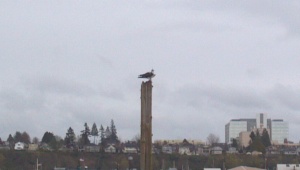
I was one whooped puppy after my second beach walk and headed home for some dinner and some sleep before the night ops began. I enlisted my good buddy Kenny (known as Flasher – he owns a fishing tackle company named Qcove that builds salmon Flashers) to help me and told him to bring his chest waders as he would be the sherpa of all the equipment. I was able to get a couple hours of sleep before the alarm went off at 2300. I picked up Flasher on the way and we geared up and headed out in the boat. It was absolutely down pouring and small craft advisory type weather. We pressed our boat up in the mud as close as possible and tossed the anchor. Flasher hauled the pumps, and towline over to the stricken vessel and we got all rigged up and pump in place. My response boat has a 2″ dewatering pump that rides 24 / 7 with the boat and it get hammered in the salty environment. I took it home in the afternoon and lubed up the impeller good and ran it for about 10 minutes to ensure I would perform when needed. The Seattle boat that was coming to help also carried a 3″ dewatering pump, but he was running late due to the nasty weather and he had about 30NM to run to get to our location. He finally arrived and we got his towline all connected and had ready with the pumps. The tide had risen and the water was filling in around the boat’s hull and my boat was completely floating again. We had Flasher start pumping and the stern started lifting after about 20 minutes of continuous pumping. When Flasher walked to the opposite side of the boat we saw the stern wobble with the weight shift so we knew it was starting to float free. Both towboats pulled gently, with me pulling from the bow and the other from the stern. The old Pacemaker popped right off the rocks and I towed to deeper water and Flasher released the stern towline from the other towboat while continuing to run the pumps. We towed her up river to the marina haul out and were a bit more than an hour ahead of schedule for our haul out at 0300. With an hour to wait, we just monitored the pumps, which had to be run about 5 minutes out of every 15 minutes to keep ahead of the water. The haul out crew arrived and lifted the boat out and we were able to get a good look at the bottom. The props were smoked and one rudder had a huge chunk out of it, but I’m fairly certain it was already like that.
In the slings:

As you can see the water is pouring out of both shaft logs. I have serious doubts that this boat was not on a planned run to be scuttled / sank to save the owner moorage fees.
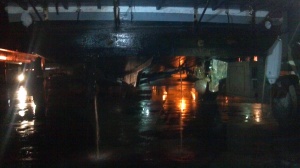
Flasher & L collected all of our lines, pumps, etc. and headed home. I hit my pillow at 0430.
I wanted to wait to the end to mention another side story that happened yesterday. On one of my trips to the marina while heading West on Everett Avenue, there is a point where you crest the hill and get your first view of Puget Sound and Port Gardner Bay (Port Gardner Bay is the harbor in Everett). As I caught the first glimpse of the bay, there was an unusual amount of bright light in the moorage area and it was clear a large ship had docked. As I got closer I was awe struck as it turned out to be Edison Chouest‘s AIVIQ! I knew she was big, but holy smokes. I drove as close as could to get a picture:
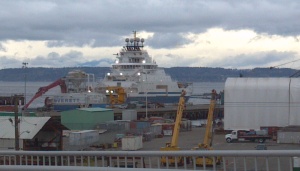
The part of harbor they are docked in is patroled by the Navy as you have to basically enter the inner harbor right past the Navy ships. Tomorrow I’m going to try to take a little harbor tour and see this beast up close. If anyone has any contacts for this ship and can arrange a tour for me, I’d owe you a beer! So while laying in bed this morning, I checked Marine Traffic to make sure she hadn’t left and I got another bonus! Crowley’s biggest baddest tug, the Ocean Wave is tied up just down the dock. I’m really hoping I can slide in the harbor for some photos (I’ll even bring a real camera). Stand by to stand by and hopefully tomorrow I will have another post.
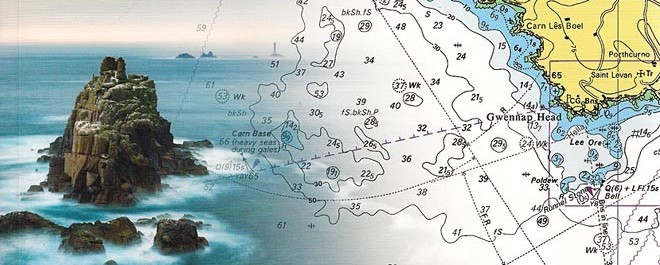
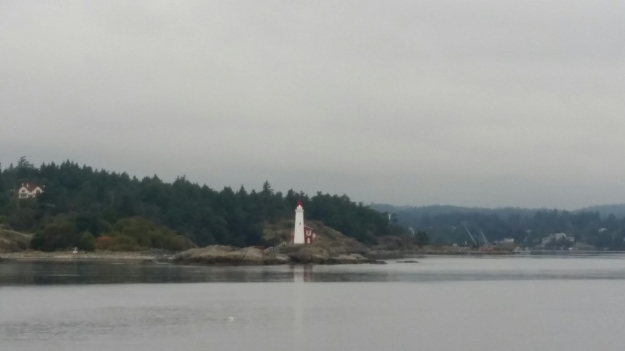

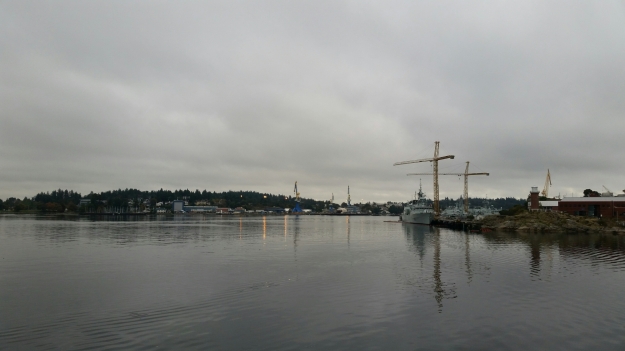
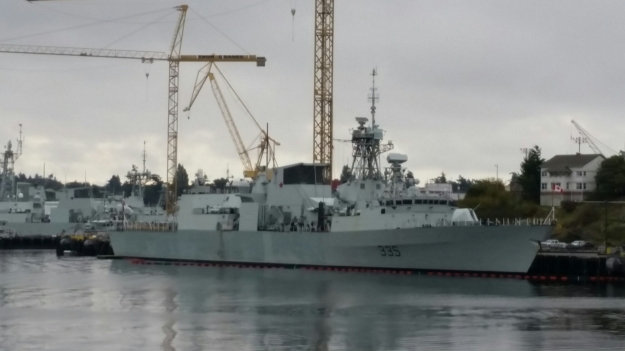
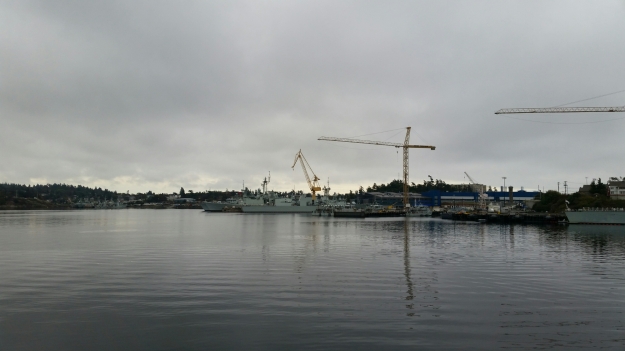
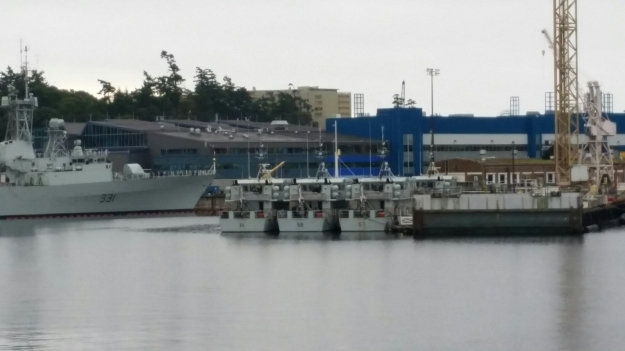
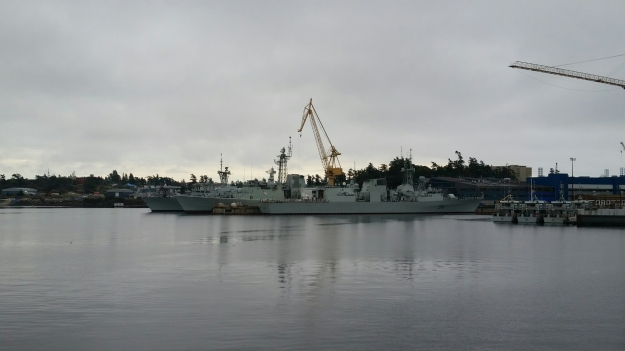
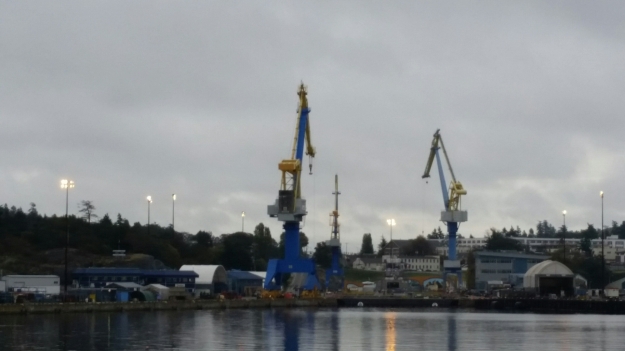


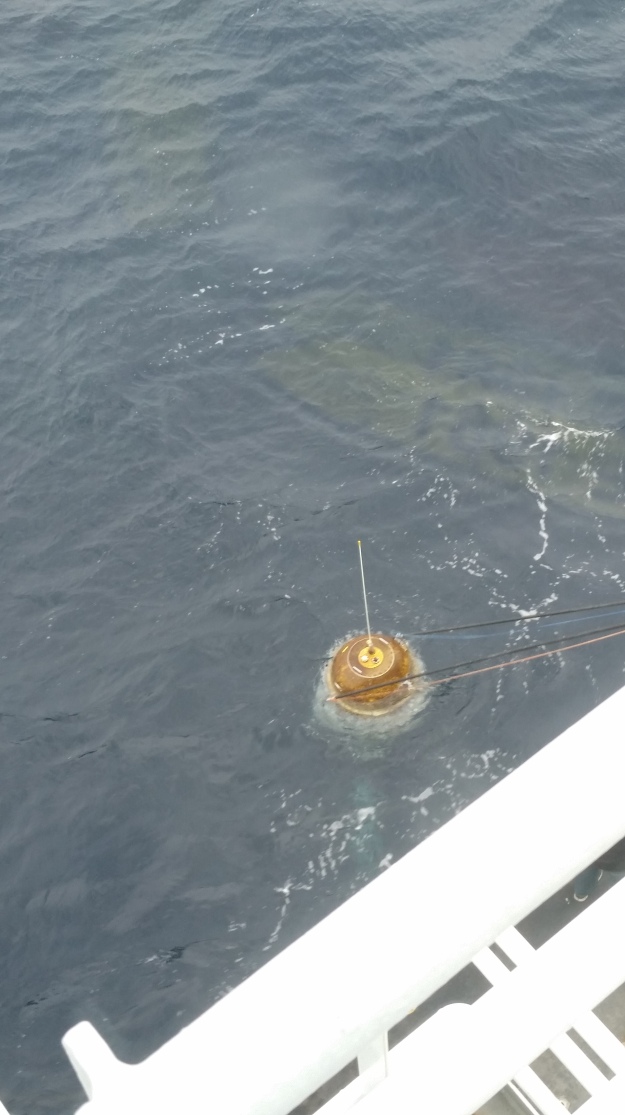


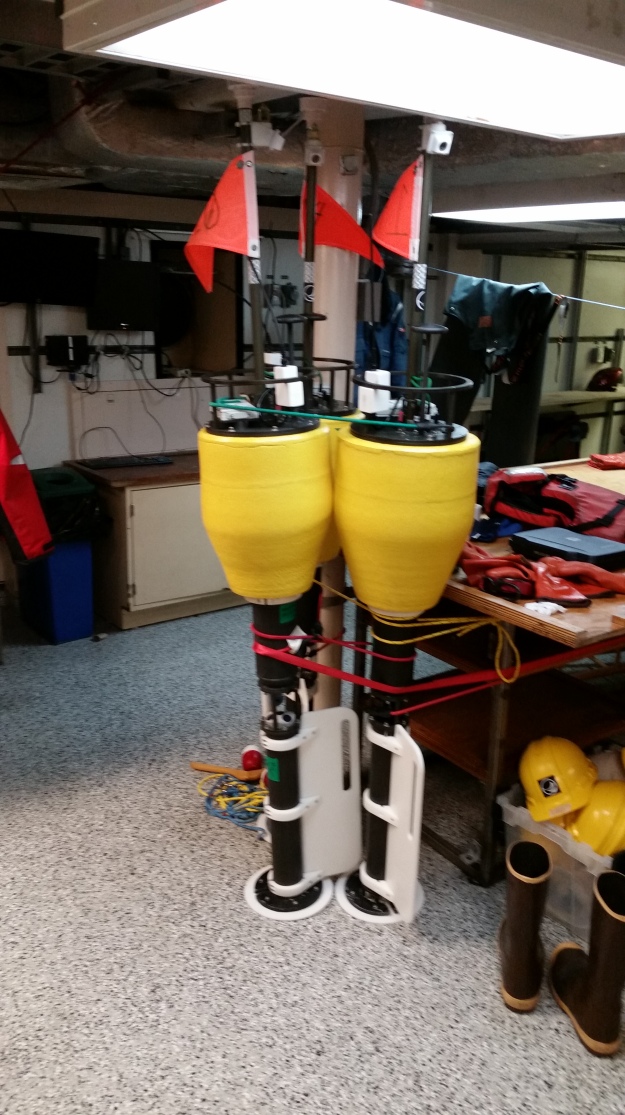
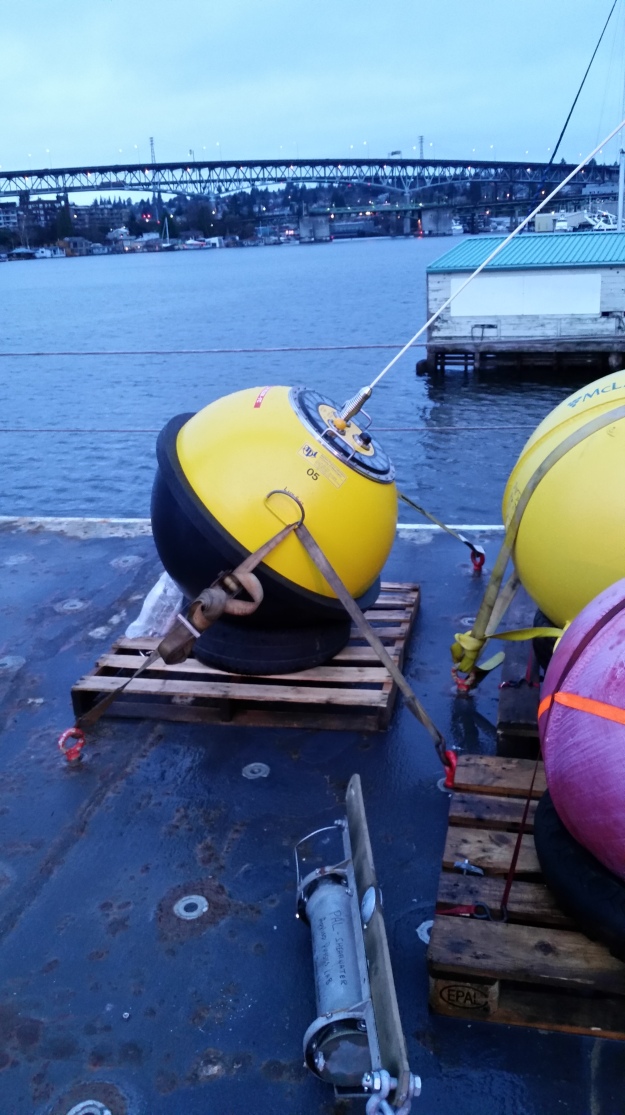
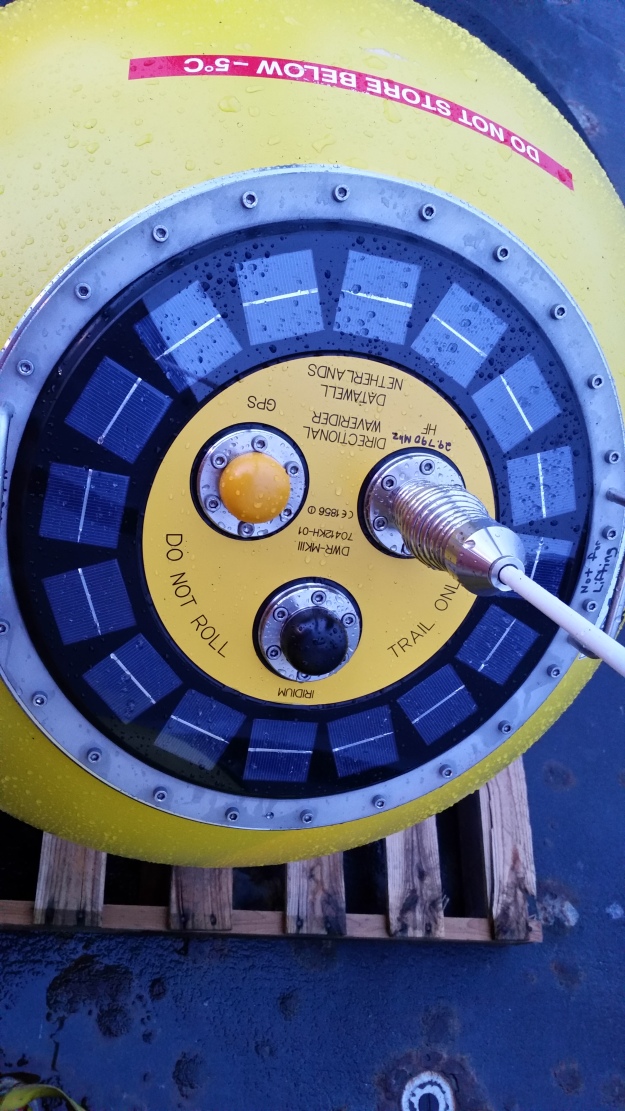
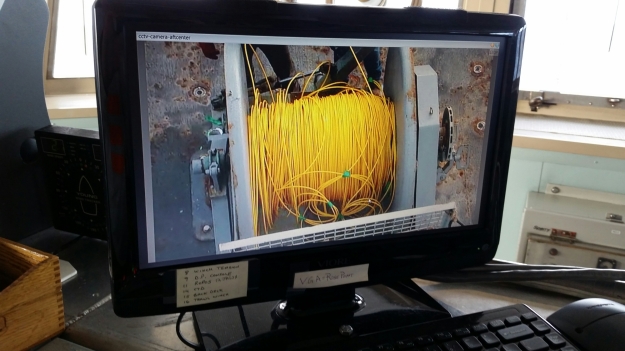
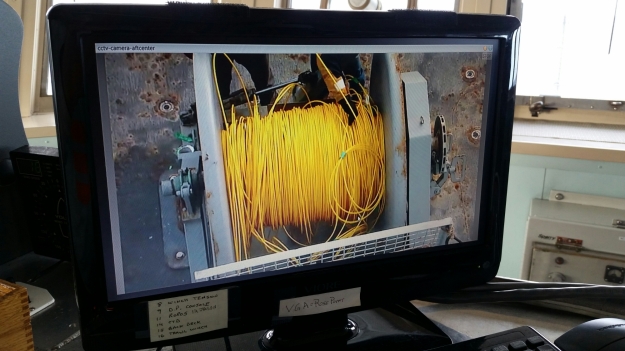
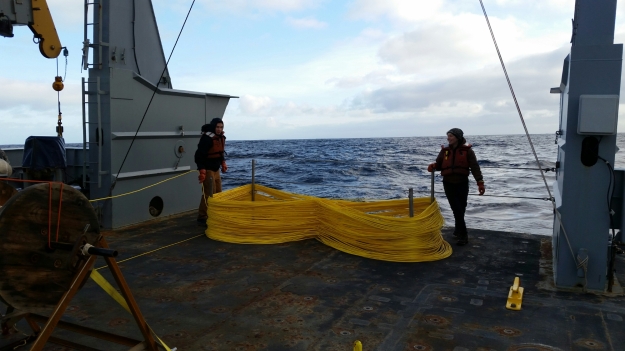
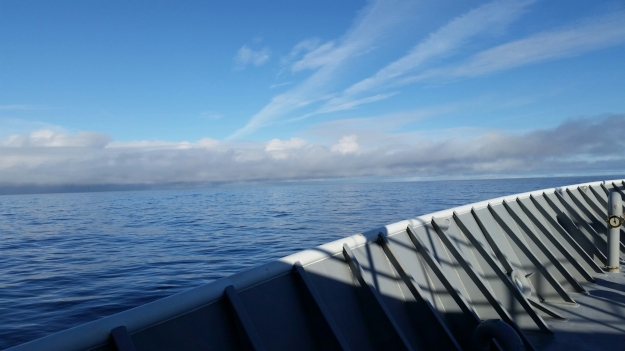
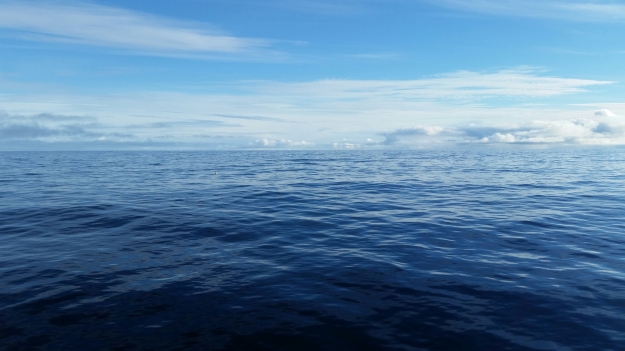



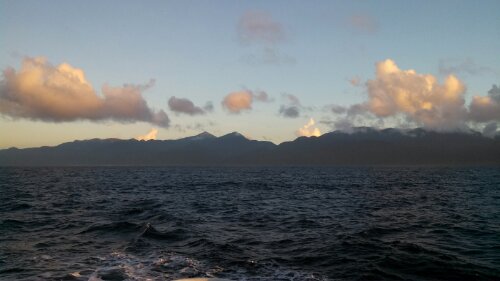

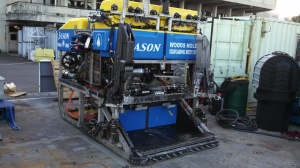
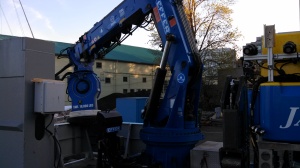

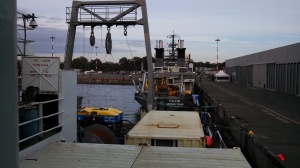


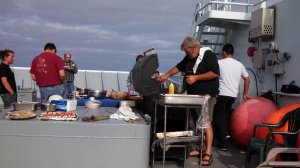

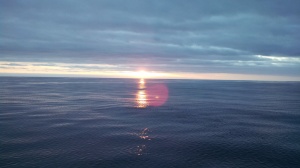

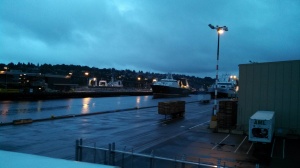
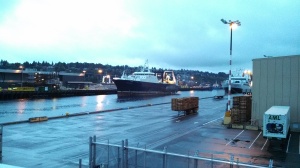



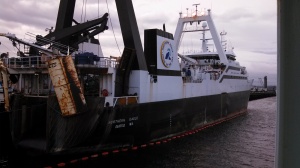
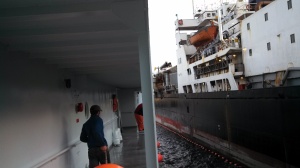


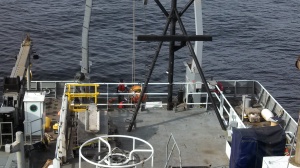
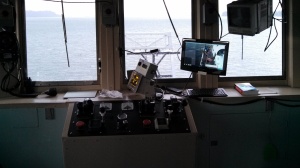
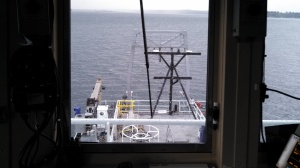
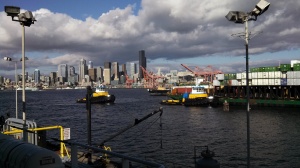
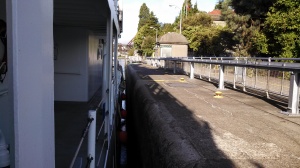
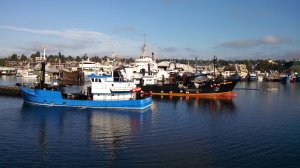

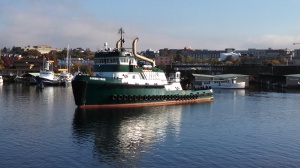




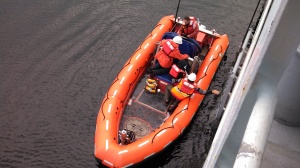
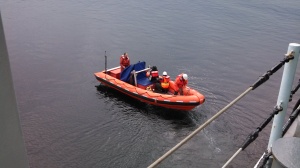
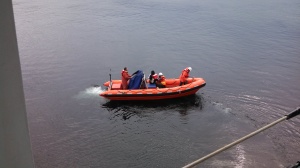


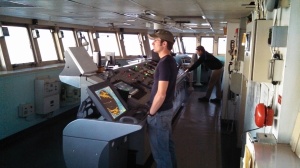
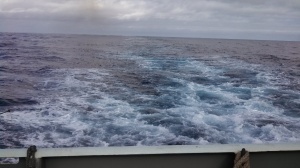
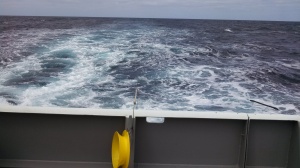
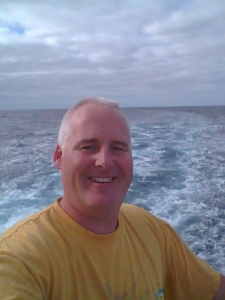

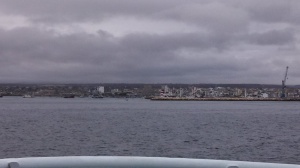
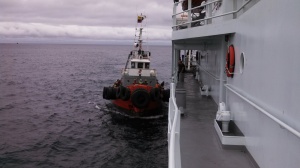
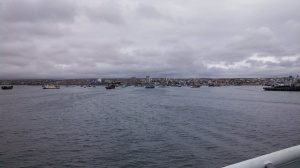
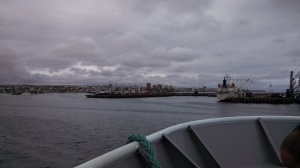


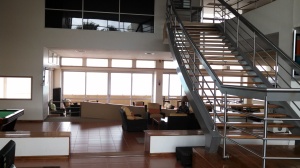
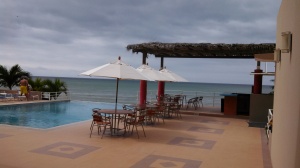
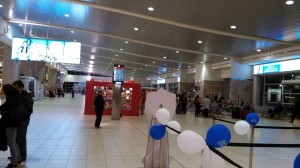
![2544_10151786015544620_116760059_n[1]](https://blueoceanmariner.files.wordpress.com/2013/10/2544_10151786015544620_116760059_n1.jpg?w=225&h=300)
![553905_10151786015389620_872518465_n[1]](https://blueoceanmariner.files.wordpress.com/2013/10/553905_10151786015389620_872518465_n1.jpg?w=300&h=225)
![1385323_10151785509839620_2112334557_n[1]](https://blueoceanmariner.files.wordpress.com/2013/10/1385323_10151785509839620_2112334557_n1.jpg?w=225&h=300)
![1383551_10151786015329620_14348265_n[1]](https://blueoceanmariner.files.wordpress.com/2013/10/1383551_10151786015329620_14348265_n1.jpg?w=300&h=225)
![1381427_10151786015454620_475878214_n[1]](https://blueoceanmariner.files.wordpress.com/2013/10/1381427_10151786015454620_475878214_n1.jpg?w=300&h=225)
![1375286_10151786015279620_1008210202_n[1]](https://blueoceanmariner.files.wordpress.com/2013/10/1375286_10151786015279620_1008210202_n1.jpg?w=225&h=300)
